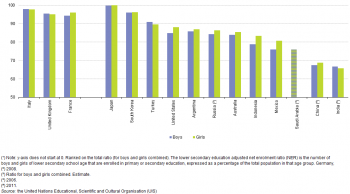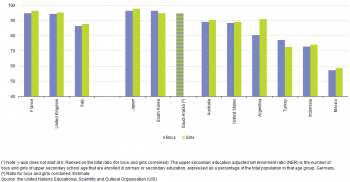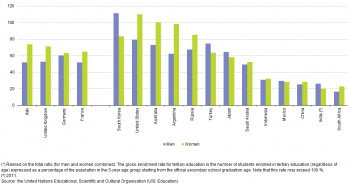Archive:The EU in the world - education and training
- Data extracted in March 2015. Most recent data: Further Eurostat information, Main tables and Database.
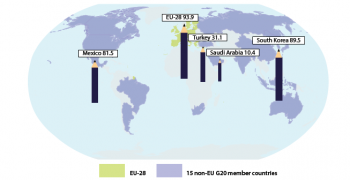
(%)
Source: Eurostat (for more information see figure 4 below)
The infographic shows EU‑28 as well as the two G20 members with the highest values and the two with the lowest values. Note that the size of the symbols does not show a precise representation of the underlying data values, but illustrates the highest and lowest values.

(%)
Source: Eurostat (for more information see figure 4 below)
The infographic shows EU‑28 as well as the two G20 members with the highest values and the two with the lowest values. Note that the size of the symbols does not show a precise representation of the underlying data values, but illustrates the highest and lowest values.
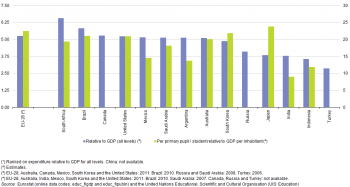
(%)
Source: Eurostat (educ_figdp) and (educ_fipubin) and the United Nations Educational, Scientific and Cultural Organisation (UIS: Education)
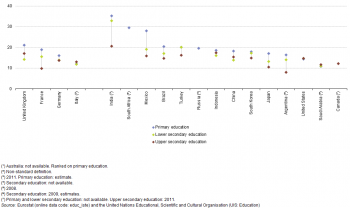
(average number of pupils per teacher)
Source: Eurostat (educ_iste) and the United Nations Educational, Scientific and Cultural Organisation (UIS: Education)

(male/female ratio)
Source: Eurostat (educ_enrl1tl) and the United Nations Educational, Scientific and Cultural Organisation (UIS: Education)
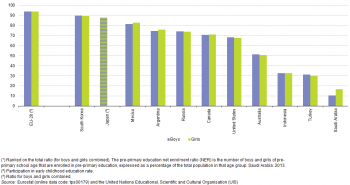
(% of total population of pre-primary school age)
Source: Eurostat (tps00179) and the United Nations Educational, Scientific and Cultural Organisation (UIS)
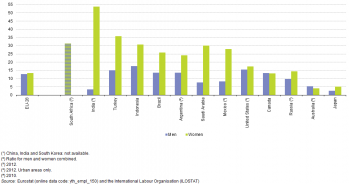
(%)
Source: Eurostat (yth_empl_150) and the International Labour Organisation (ILOSTAT)
This article is part of a set of statistical articles based on Eurostat’s publication The EU in the world 2015.
The article focuses on education and training statistics in the European Union (EU) and in the 15 non-EU members of the Group of Twenty (G20). It covers a range of subjects, including: educational expenditure, personnel, participation rates and attainment and gives an insight into education in the EU in comparison with the major economies in the rest of the world, such as its counterparts in the so-called Triad — Japan and the United States — and the BRICS composed of Brazil, Russia, India, China and South Africa.
Main statistical findings
The level of educational enrolment depends on a wide range of factors, such as the age structure of the population, legal requirements concerning the start and duration of compulsory education, and the availability of educational resources.
Educational expenditure
Public educational expenditure relative to GDP was highest in South Africa at 6.6 %
Public expenditure on education includes spending on schools, universities and other public and private institutions involved in delivering educational services or providing financial support to students. The cost of teaching increases significantly as a child moves through the education system, with expenditure per pupil/student considerably higher in universities than in primary schools. Comparisons between countries relating to levels of public expenditure on education are influenced by differences in price levels and by numbers of pupils and students.
Figure 1 provides information on the level of public expenditure relative to gross domestic product (GDP). Among the G20 members this was highest in 2012 in South Africa at 6.6 %, while it was less than 5.0 % in South Korea and Russia, below 4.0 % in Japan, India and Indonesia, and below 3.0 % in Turkey. The EU-28 ranked among a group of G20 members whose public expenditure on education accounted for 5.1 % to 5.8 % of GDP.
Figure 1 also presents the average public expenditure per pupil or student in education in relation to GDP per inhabitant. This measure is similar to the relative size of public education expenditure compared with GDP, but is adjusted for the proportion of pupils and students within the whole population, in other words the share of the population on which that relative expenditure is focused. From this indicator it can be seen that — when the relatively small number of pupils and students within the whole population is taken into account — the EU-28’s public expenditure on education relative to GDP was the second highest among the G20 members after Japan. Apart from Japan and the EU, South Korea, Brazil, the United States and Australia recorded relatively high values for this indicator.
Numbers of teachers and pupils
In general, pupil-teacher ratios were lowest for upper secondary education and highest for primary education
Figure 2 shows the pupil-teacher ratio for primary and secondary education among the G20 members. These ratios are calculated by dividing the number of full-time equivalent pupils and students by the number of full-time equivalent educational personnel. A full-time equivalent is a unit to measure employed persons or students in a way that makes them comparable although they may work or study a different number of hours per week. The unit is obtained by comparing the number of hours worked or studied by a person with the average number of hours of a full-time worker or student. A full-time person is therefore counted as one unit, while a part-time person gets a score in proportion to the hours they work or study. In 2012, the average number of pupils per teacher was generally lowest for upper secondary education and highest for primary education, with the main exceptions recorded for members where the ratios were very similar across all three levels of education, such as in Saudi Arabia, and to a lesser extent, Indonesia, China, Italy and the United Kingdom. Overall, Saudi Arabia had the lowest pupil-teacher ratios and India the highest.
Starting school and duration
The earliest starting age for compulsory education among G20 members was four years old in Brazil and Mexico, while the latest was seven years old in Indonesia and South Africa. Among the G20 EU Member States the starting age was five in the United Kingdom (four in Northern Ireland) and six elsewhere. The duration of compulsory education in G20 members ranged from eight years in India to 14 years in Brazil and Mexico. As a result the earliest leaving age was around 14 in India and reached 18 or 19 in the United States, Turkey, Mexico, Brazil, Argentina, Italy and Germany.
School enrolment
There were more boys than girls in primary education in all G20 members (see Table 1). The imbalance in primary education enrolment generally remained stable or narrowed between 2002 and 2012, with China, the United States, South Africa and Brazil the only G20 members reporting an increase.
In nearly all G20 members boys outnumber girls in primary and secondary education
Within lower secondary education, boys also outnumbered girls in all G20 members except in Mexico, while for upper secondary education there were a few more exceptions, namely Brazil, Argentina and South Africa, as well as Mexico. Australia, Brazil and Saudi Arabia reported an increasing gender imbalance within their lower and upper secondary education systems between 2002 and 2012, regardless of whether it was in favour of girls (as was the case in Brazil for upper secondary education) or in favour of boys. For lower secondary education, Russia and the EU-28 also reported an increasing imbalance in favour of boys, while for upper secondary education Japan and South Korea reported an increasing imbalance in favour of boys and Argentina an increasing imbalance in favour of girls. India reported a particularly large narrowing of the gender imbalance between 2002 and 2012 in all three stages of education shown in Table 1, as did Turkey, particularly in upper secondary education. A gender imbalance in schools may simply reflect a gender imbalance in the school age population, or it may result from differences in enrolment rates.
Figures 4 to 8 present enrolment ratios for various education levels. Three types of enrolment ratios are presented, namely net, adjusted net and gross ratios. Net ratios (shown in Figures 4 and 5 for pre-primary and primary education) compare the number of pupils/students of the appropriate age group enrolled at a particular level of education with the size of the population of the same age group; these ratios cannot exceed 100 %. Adjusted net ratios (shown in Figures 6 and 7 for lower and upper secondary) look at the age group corresponding to a particular level of education and show the share that are in any level of primary or secondary education, in other words including those who are enrolled in levels for which they are formally too young or too old; again these cannot exceed 100 %. Gross ratios (shown in Figure 8 for tertiary education) compare the number of pupils/students enrolled at a particular level with the size of the population of the appropriate age group (or approximation thereof); these ratios can exceed 100 % due to under or over age children being enrolled in the selected level of education.
The EU has set a target of 95 % participation in early childhood education by 2020 (Education and training 2020). This indicator relates to the share of the population which participates in early education among those aged between four years and the age when compulsory education starts. In 2002, the early childhood education rate in the EU-28 was 87.7 % and this rose to 93.9 % by 2012. Figure 4 presents the early childhood education rate for boys and girls for the EU-28 and a similar indicator, the net enrolment ratio for pre-primary education, for other G20 members. In 2012, the net enrolment ratio in pre-primary education was particularly low in Saudi Arabia (13 % in 2013), and was also below one third in Turkey (31 %) and Indonesia (33 %). Elsewhere, the ratio ranged from 51 % in Australia (2010 data) to 90 % in South Korea (2011 data). In the EU-28, the early childhood education rate was fractionally higher for girls than for boys. In most G20 members the gender gap for the net enrolment ratio was relatively small, with the exception of Saudi Arabia where there was a particularly large gap in favour of girls.
Primary education was effectively universal in Japan and the United Kingdom
Moving on from pre-primary education, enrolment in primary education was effectively universal in Japan, Canada (1999 data) and the United Kingdom for both boys and girls, with ratios of 98 % or higher also recorded for Argentina (2003 data), South Korea and France (see Figure 5). Among the other G20 members, the primary education net enrolment ratio for boys and girls fell below 95 % in Turkey, India, Indonesia, the United States and South Africa, while for boys it was also below this share in Saudi Arabia. As for pre-primary education, primary education enrolment ratios for boys and girls were quite similar in all G20 members with the exception of Saudi Arabia.
Figures 6 and 7 present the adjusted net enrolment ratios for lower and upper secondary education. For both of these levels Japan reported the highest ratios, with universal enrolment in lower secondary education and a 97.2 % ratio for upper secondary education. Net enrolment ratios below 80 % were recorded for lower secondary education in Indonesia (boys only), Mexico (boys only), Saudi Arabia, China (2006 data) and India (2011 data). In a similar manner, ratios below 80 % were recorded for Turkey, Indonesia and Mexico for upper secondary education.
Gender differences were somewhat more pronounced for lower and upper secondary education than for either pre-primary or primary education. In most of the G20 members shown in Figure 6 the ratios for girls were higher than for boys, with the exceptions of Turkey, India, the United Kingdom and Italy. The ratios for upper secondary education showed an even clearer picture, with only Turkey and South Korea reporting higher ratios for boys. For lower secondary education, the largest gender gaps were observed for Mexico, Indonesia and the United States, while for upper secondary education Argentina and Turkey had by far the largest gender gaps, the former in favour of girls and the latter in favour of boys.
South Korea and the United States had the highest gross enrolment rates for tertiary education
Tertiary education is generally provided by universities and other higher education institutions. In 2012, there were 20.2 million tertiary education students in the EU-28; worldwide, tertiary education enrolment was 196 million. The gross enrolment ratio shown in Figure 8 is calculated as a share of the five-year age group starting from the official secondary school graduation age and as such is influenced by the proportion of people who undertake tertiary studies as well as by the average length of these studies. Unlike the secondary education ratios, these ratios varied greatly among the G20 members: the highest ratios, in excess of 90 %, were recorded in South Korea and the United States; Australia, Argentina and Russia also recorded ratios over 75 %; a group of members, including the four G20 EU Member States, recorded ratios between 50 % and 70 %; in Indonesia, Mexico and China the ratios were between 25 % and 33 %; the lowest gross enrolment ratios for tertiary education were in India and South Africa, both below 25 %.
Most G20 members, including all four G20 EU Member States, reported higher gross enrolment ratios for tertiary education for women than for men, with the largest gender gaps in favour of women reported by Argentina, the United States and Australia. By contrast, enrolment rates were higher for men in Mexico, India, Japan, Turkey and, most notably, South Korea.
Not in employment, education or training
Japan and Australia had the lowest proportion of young people not in employment, education or training
Traditional analyses of the labour market focus on employment and unemployment, but for younger people many are still in education. Labour market policies for young people often focus on those who are not in employment, education or training, abbreviated as NEETs. Factors that affect the proportion of young people not in employment, education or training include the length of compulsory education, types of available educational programmes, access to tertiary education, as well as labour market factors related to unemployment and economic inactivity (being neither employed nor unemployed). Figure 9 indicates the proportion of 15–24 years olds that were not enrolled in education (school or formal training) nor employed in 2013. Among the G20 members this ranged from 5 % or less in Australia (2010 data) and Japan, through 12 % for Russia (2012 data) and 13 % for the EU-28 to 24 % in Indonesia, 26 % in Turkey, 27 % in India (2012 data) and 31 % in South Africa.
Data sources and availability
The statistical data in this article were extracted during March 2015.
The indicators are often compiled according to international — sometimes global — standards. Although most data are based on international concepts and definitions there may be certain discrepancies in the methods used to compile the data.
EU data
Most if not all of the indicators presented for the EU have been drawn from Eurobase, Eurostat’s online database. Eurobase is updated regularly, so there may be differences between data appearing in this article and data that is subsequently downloaded. In exceptional cases, such as the data for enrolment rates and youth literacy rates, some indicators for the EU have been extracted from international sources.
G20 members from the rest of the world
For the 15 non-EU G20 members, the data presented have been extracted from a range of international sources, namely the United Nations Educational, Scientific and Cultural Organisation, the United Nations Statistics Division and the International Labour Organisation. For some of the indicators shown a range of international statistical sources are available, each with their own policies and practices concerning data management (for example, concerning data validation, correction of errors, estimation of missing data, and frequency of updating). In general, attempts have been made to use only one source for each indicator in order to provide a comparable analysis between the members.
Context
Education and training help foster economic growth, enhance productivity, contribute to people’s personal and social development, and reduce social inequalities. In this light, education and training has the potential to play a vital role in both an economic and social context. Education statistics cover a range of subjects, including: expenditure, personnel, participation rates and attainment. The standards for international statistics on education are set by three international organisations: the Institute for Statistics of the United Nations Educational, Scientific and Cultural Organisation; the OECD; and Eurostat.
The classification used to distinguish different levels of education is the International Standard Classification of Education (ISCED). The version used in this publication is ISCED 1997 which has seven levels of education.
- Level 0 pre-primary education — for children aged at least three years.
- Level 1 primary education — begins between five and seven years of age.
- Level 2 lower secondary education — usually, the end of this level coincides with the end of compulsory education.
- Level 3 upper secondary education — entrance age is typically 15 or 16 years.
- Level 4 post-secondary non-tertiary education — between upper secondary and tertiary education; serves to broaden the knowledge of level 3 graduates.
- Levels 5 and 6 first and second stages of tertiary education — includes programmes with academic and occupational orientations as well as those that lead to an advanced research qualification.
See also
- All articles on the non-EU countries
- Educational expenditure statistics
- Other articles from The EU in the world
- Early leavers from education and training
- Tertiary education statistics
Further Eurostat information
Publications
- The European Union and the African Union — 2014 edition
- Asia-Europe Meeting (ASEM) — A statistical portrait — 2014 edition
- The EU in the world 2014
- Key figures on the enlargement countries — 2014 edition
- Pocketbook on Euro-Mediterranean statistics — 2013 edition
- The EU in the world 2013
- The European Union and the BRIC countries
- The European Union and the Republic of Korea — 2012
- Key data on education in Europe 2012
Main tables
- Education (t_educ)
- Education indicators - non-finance (t_educ_indic)
- Participation in early childhood education (tps00179)
- Education indicators - non-finance (t_educ_indic)
Database
- Education (educ)
- Education indicators - non-finance (educ_indic)
- Pupil/Student - teacher ratio and average class size (ISCED 1-3) (educ_iste)
- Indicators on education finance (educ_finance)
- Expenditure on education as % of GDP or public expenditure (educ_figdp)
- Expenditure on public educational institutions (educ_fipubin)
- Enrolments, graduates, entrants, personnel and language learning - absolute numbers (educ_isced97)
- Students by ISCED level, age and sex (educ_enrl1tl)
- Education indicators - non-finance (educ_indic)
- Youth (yth), see:
- Youth employment (yth_empl)
- Young people not in employment and not in any education and training by sex, age and activity status (yth_empl_150)
Dedicated section
- Education and training
- Employment and social policy see Youth indicators
- Youth
Source data for tables and figures (MS Excel)
![]() Education and training: tables and figures
Education and training: tables and figures
External links
- International Labour Organisation ILO
- United Nations Educational, Scientific and Cultural Organization UNESCO
- United Nations Statistics Division


